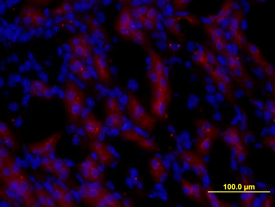Mouse Pro EGF Antibody Summary
Trp29-Arg1029
Accession # P01132
Applications
Please Note: Optimal dilutions should be determined by each laboratory for each application. General Protocols are available in the Technical Information section on our website.
Scientific Data
 View Larger
View Larger
Pro EGF in Mouse Kidney. Pro Epidermal Growth Factor (Pro EGF) was detected in perfusion fixed frozen sections of mouse kidney using Rat Anti-Mouse Pro EGF Monoclonal Antibody (Catalog # MAB5256) at 10 µg/mL for 3 hours at room temperature. Tissue was stained (red) and counterstained with DAPI (blue). View our protocol for Fluorescent IHC Staining of Frozen Tissue Sections.
Reconstitution Calculator
Preparation and Storage
- 12 months from date of receipt, -20 to -70 °C as supplied.
- 1 month, 2 to 8 °C under sterile conditions after reconstitution.
- 6 months, -20 to -70 °C under sterile conditions after reconstitution.
Background: EGF
EGF is the prototypic member of a family of growth factors that also includes amphiregulin, betacellulin, epigen, epiregulin, HB-EGF, neuregulins-1 through -6, and TGF-alpha (1). These proteins contain EGF-like domains with three intramolecular disulfide bonds between conserved cysteines (2). EGF family members are synthesized as transmembrane preproproteins with varying numbers of EGF-like domains (3). The extracellular region of mouse pro-EGF contains eight LDL R class B repeats and nine EGF-like domains (4). Mature EGF is derived from the juxtamembrane EGF-like domain. EGF binds ErbB1 and induces the formation of homodimers or heterodimers containing ErbB2 (5). Pro-EGF is most highly expressed in the submaxillary gland and kidney (6). In the kidney, the 190 kDa preproprotein is cleaved by membrane-associated serine proteases, liberating the extracellular region which is subsequently processed into smaller fragments including the 6 kDa mature EGF (7‑10). The various cleavage products produced in the kidney also are present in urine (9‑11). In the submaxillary gland, however, nearly all EGF is processed intracellularly and stored in secretory vesicles (6, 12). The soluble precursor binds ErbB1 and induces cellular proliferation, although it is significantly less potent than mature EGF (8, 9). In human thyroid carcinoma cells, a splice variant of pro-EGF with a deletion in the cytoplasmic domain induces increased proliferative activity relative to wild-type pro-EGF (13). Within the extracellular region, mouse pro-EGF shares 79% amino acid sequence identity with rat pro-EGF and 67%‑69% with human, canine, feline, and porcine pro-EGF.
- Singh, A.B. and R.C. Harris (2005) Cell. Signal. 17:1183.
- Wouters, M.A. et al. (2005) Prot. Sci. 14:1091.
- Sanderson, M.P. et al. (2006) Growth Factors 24:121.
- Gray, A. et al. (1983) Nature 303:722.
- Jorissen, R.N. et al. (2003) Exp. Cell Res. 284:31.
- Rall, L.B. et al. (1985) Nature 313:228.
- Le Gall, S.M. et al. (2004) Regul. Pept. 122:119.
- Breyer, J.A. and S. Cohen (1990) J. Biol. Chem. 265:16564.
- Parries, G. et al. (1995) J. Biol. Chem. 270:27954.
- Le Gall, S.M. et al. (2003) J. Biol. Chem. 278:45255.
- Lakshmanan, J. et al. (1990) Biochem. Biophys. Res. Commun. 173:902.
- Pasquini, F. et al. (1974) Exp. Cell Res. 86:233.
- Pyka, J. et al. (2005) Cancer Res. 65:1343.
Product Datasheets
FAQs
No product specific FAQs exist for this product, however you may
View all Antibody FAQsReviews for Mouse Pro EGF Antibody
Average Rating: 5 (Based on 1 Review)
Have you used Mouse Pro EGF Antibody?
Submit a review and receive an Amazon gift card.
$25/€18/£15/$25CAN/¥75 Yuan/¥2500 Yen for a review with an image
$10/€7/£6/$10 CAD/¥70 Yuan/¥1110 Yen for a review without an image
Filter by:






